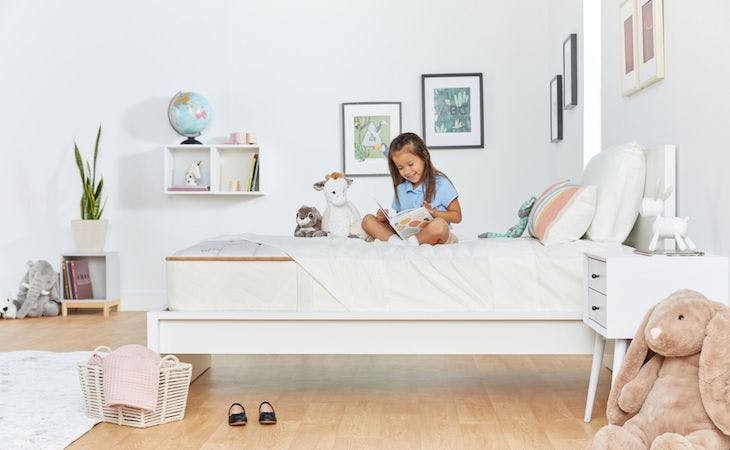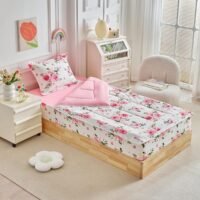Are you choosing a mattress for your child? Consider the size difference between twin and full mattresses: twin beds are narrower, while full beds are more expansive, offering more space for growing children.

Importance Of Choosing The Right Mattress
Choosing the right mattress for your child is essential for their growth and development. A mattress that provides proper support and a comfortable sleep environment can significantly impact their sleep quality and health. By understanding the importance of selecting the right mattress, you can make an informed decision to benefit your child’s well-being.
Proper Support For Growing Bodies
Growing bodies require proper support during sleep to promote healthy development. A mattress that offers adequate support helps to align the spine and promote good posture. It prevents the growth of any pressure points that can lead to discomfort or pain. Choosing a mattress that supports their growing bodies can help avoid issues such as backaches or poor sleep posture.
Creating A Comfortable Sleep Environment
Creating a comfortable sleep environment is crucial for your child’s sleep quality. A mattress that is too firm or soft can lead to discomfort, restlessness, and disrupted sleep. By selecting the right mattress, you can ensure your child enjoys a peaceful and comfortable sleep, allowing them to wake up refreshed and ready for the day ahead.
Mattress type, firmness level, and material are vital in creating a comfortable sleep environment. Memory foam mattresses, for example, contour to the body’s shape, providing personalized support and reducing pressure points. On the other hand, innerspring mattresses offer a bouncy feel and excellent breathability.
Additionally, consider the size of the mattress. A twin mattress may be popular with younger children, while a full-size mattress provides extra space as they grow. Choosing a size that allows your child to sleep comfortably and move freely without feeling confined is crucial.
In Conclusion
Choosing the right mattress for your child is essential for their overall well-being. Providing proper support for their growing bodies and creating a comfortable sleep environment will improve their sleep quality and promote healthy development. By considering factors such as support, comfort, and size, you can select the perfect mattress to ensure your child gets the restful sleep they need.
Understanding The Difference Between Twin And Full Mattresses
When choosing the perfect mattress for your child, understanding the difference between twin and full mattresses is crucial. Twin and full mattresses are famous for kids, offering different sizes and functionalities. In this article, we’ll dive into the details of these mattress sizes, dimensions, usage, and functionality.
Size And Dimensions
A key factor to consider when selecting a mattress for your child is the size and dimensions. Twin mattresses are known for their smaller size, measuring 39 inches in width and 75 inches in length. On the other hand, full mattresses, also known as double mattresses, are more significant, measuring 54 inches in width and 75 inches in length.
Let’s break down the differences between the two mattress sizes:
| Size | Dimensions |
|---|---|
| Twin | 39 inches by 75 inches |
| Full | 54 inches by 75 inches |
As you can see, full mattresses provide your child with extra space to move around, making them ideal for sleepovers or shared bedrooms. However, a twin mattress might be the perfect choice if you have limited space or your child prefers a cozy sleeping environment.
Usage And Functionality
Another crucial aspect to consider is the usage and functionality of the mattress. Twin mattresses are commonly used in children’s bedrooms, guest rooms, or small apartments. Their smaller size provides ample space for a single sleeper without occupying too much room.
On the other hand, full mattresses are versatile and can accommodate both children and adults comfortably. This makes them an excellent choice for growing children, who may prefer more space as they age. Full mattresses can easily transition from a child’s bedroom to a teenager’s room, ensuring long-lasting functionality.
Before choosing a mattress for your child, consider their age, sleeping preferences, and future needs. A full mattress can offer added functionality if they have the space and enjoy having sleepovers. If space is limited or your child prefers a snug sleeping space, a twin mattress might be a better option.
In conclusion, understanding the difference between twin and full mattresses is essential when selecting the right mattress for your child. Consider the size, dimensions, usage, and functionality to make an informed decision. Choosing the perfect mattress ensures your child gets the quality sleep they need for optimal growth and development.
Determining Your Child’s Sleep Needs
When choosing a mattress for your child, it is crucial to consider their sleep needs. Understanding their age, growth stage, and sleeping habits and preferences will help you make an informed decision. Let’s investigate these factors to ensure your child gets the best possible sleep.
Age And Growth Stage
Age and growth stage are pivotal in determining the type of mattress your child requires. Their bodies undergo significant changes as they grow, and their sleep needs evolve accordingly. Here’s a breakdown of what to consider for different age groups:
| Age | Mattress Size Recommendation |
|---|---|
| Infants and Toddlers | A crib or a toddler bed with a standard crib mattress. |
| Preschoolers and Young Children | A twin-size mattress for their growing bodies. |
| Tweens and Teens | A full-size mattress to accommodate their rapid growth spurt. |
Sleeping Habits And Preferences
Sleeping habits and preferences also play a significant role in deciding the right mattress for your child. Each child has a unique way of sleeping, and understanding their preferences will help achieve optimal comfort and support. Consider the following factors:
- Position: If your child tends to sleep on their back, a firmer mattress can provide ample support for their spine. A slightly softer mattress can cushion the hips and shoulders for side sleepers.
- Temperature: If your child feels hot while sleeping, opting for a mattress with cooling properties, such as those made of breathable materials, can help regulate their body temperature.
- Allergies: If your child is prone to allergies, selecting a hypoallergenic mattress can help minimize exposure to allergens and create a healthier sleep environment.
By considering their age, growth stage, and sleeping habits and preferences, you can ensure that your child’s mattress provides the necessary support, comfort, and safety for a restful night’s sleep. Remember, a well-rested child is a happy child!

Pros And Cons Of Twin Mattresses For Children
Pros And Cons Of Full Mattresses For Children
Choosing the right mattress for your child is crucial for their growth and development. When deciding between a twin and a full bed, certain factors must be considered. This article will discuss the pros and cons of full mattresses for children, helping you make an informed decision.
Advantages Of Full Mattresses
- Adequate Space: A full mattress provides more sleeping surface area, allowing your child to stretch out comfortably at night.
- Room for Growth: Children proliferate, and a full mattress offers the space to accommodate their increasing height and body size. It ensures they can use the mattress for a more extended period without feeling cramped.
- Comfortable for Co-Sleeping: If you occasionally sleep with your child or have siblings sharing a bed, a full mattress provides enough space for everyone to sleep comfortably.
- Multipurpose Functionality: Full mattresses can serve as a seating area during the day, doubling as a cozy spot for your child to read or play. It can also be convenient for sleepovers.
Considerations For Full Mattresses
While full mattresses offer several advantages, there are a few considerations to remember when choosing one for your child.
- Space Limitations: If your child’s bedroom is small, a full mattress may take up a significant amount of space, making it challenging to accommodate other furniture or create play areas.
- Cost: Full mattresses are generally more expensive than twin mattresses, so you must consider your budget when deciding.
- Safety Concerns: For younger children, the height of a full mattress can pose safety risks, especially if they have just transitioned from a crib. It may be advisable to wait until they are older to ensure they can safely get on and off the mattress.
- Bedding Costs: Full mattresses require more oversized bedding, including sheets, comforters, and mattress protectors. Remember that these larger-sized options may be more expensive or more complicated to find compared to twin-sized bedding.
Now that you know the pros and cons of full mattresses for children, you can decide based on your child’s specific needs and bedroom space. Consider both the advantages and considerations mentioned above to choose the mattress that will provide the most comfort and functionality for your child’s sleep environment.

Frequently Asked Questions For Twin Vs. Full: Choosing A Mattress For Your Child
Is A Twin Mattress Big Enough For A Child?
Yes, a twin mattress is usually suitable for a child. It provides enough space for their growing body and allows flexibility in arranging their room.
What is the difference between a twin mattress and a full mattress?
The main difference between a twin and a full mattress is the size. A twin mattress is 38 inches wide and 75 inches long, while a full mattress is 54 inches wide and 75 inches long. A full mattress provides more space for an older child or teenager.
How Long Can A Child Use A Twin Mattress?
A child can use a twin mattress throughout their childhood and teenage years, depending on their growth. It is recommended to assess their comfort and size needs every few years and consider upgrading to a larger size when necessary.
Is A Full Mattress Necessary For An Older Child?
A full mattress can be a good option for an older child or teenager. It provides more sleeping space and allows for a growing body’s changing sleep needs and preferences.
Conclusion
Ultimately, choosing the right mattress for your child comes down to their preferences, needs, and bedroom space. Both twin and full-size mattresses have their advantages and disadvantages. Remember, it’s essential to prioritize comfort, support, and longevity when making this decision.
By considering factors such as your child’s age, size, sleep position, and personal preferences, you can make an informed choice to provide them with a good night’s sleep for years to come.

Hi, I’m Esrat, and I’m so glad that you found me here at Happy Food Kitchen! I started Happy Food Kitchen in 2023 to have a creative, right-brained outlet to balance my very left-brained career in genetics.




